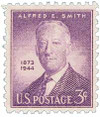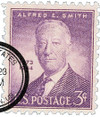
1945 3c Alfred E. Smith
# 937 - 1945 3c Alfred E. Smith
$0.35 - $45.00
Â
U.S. #937
3¢ Alfred E. Smith
3¢ Alfred E. Smith
Issue Date: November 26, 1945
City: New York, NY
Quantity: 308,587,700
Printed by: Bureau of Engraving and Printing
Printing Method: Rotary Press
Perforations: 11 x 10.5
Color: Purple
City: New York, NY
Quantity: 308,587,700
Printed by: Bureau of Engraving and Printing
Printing Method: Rotary Press
Perforations: 11 x 10.5
Color: Purple
U.S. #937 was issued to commemorate Alfred E. Smith, former governor of New York, who had died the previous year.
Â
U.S. #937
3¢ Alfred E. Smith
3¢ Alfred E. Smith
Issue Date: November 26, 1945
City: New York, NY
Quantity: 308,587,700
Printed by: Bureau of Engraving and Printing
Printing Method: Rotary Press
Perforations: 11 x 10.5
Color: Purple
City: New York, NY
Quantity: 308,587,700
Printed by: Bureau of Engraving and Printing
Printing Method: Rotary Press
Perforations: 11 x 10.5
Color: Purple
U.S. #937 was issued to commemorate Alfred E. Smith, former governor of New York, who had died the previous year.









